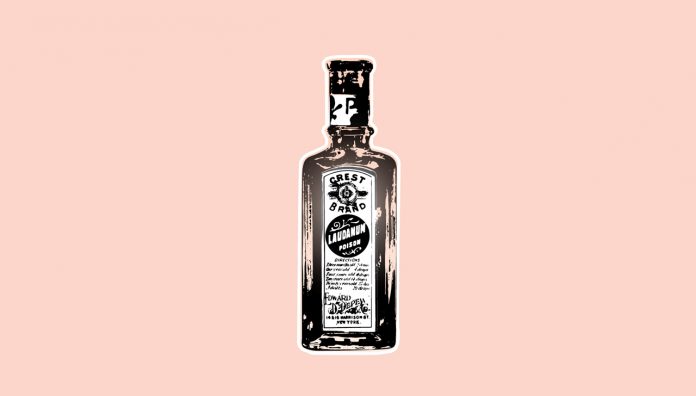Laudanum’s use, and abuse, has set the tone for the use and abuse of opiates from the 17th century until the present day.
From pre-history through Sumerian, Greek and Roman cultures, opium has been used for pain management. But it was in the preparation known as laudanum that it entered the modern world of medicine.
Formulated by renowned Swiss chemist/alchemist Paracelsus in the early Renaissance, laudanum was made up of a concoction of substances that could include pearls, musk, amber, ambergris, nutmeg and of course opium.
Many chemists formulated their own laudanum recipes, with British chemist Thomas Sydenham creating a version in the 1670s which popularised the drug in the UK and led to its spread around the world, and saw it referenced in literature of the time as ‘a panacea for all human woes … the secret of happiness’. Sydenham’s laudanum was a mix of wine, beer, saffron, clove, cinnamon and opium, and was used in treating headaches, cough and tuberculosis, gout, rheumatism, diarrhoea, menstrual pain, as well as depression (melancholy).
Laudanum would become one of the first ‘cure all’ medicines and was available freely in most jurisdictions without prescription until the 1920s.
In action
Laudanum is an opium tincture made from poppy seeds and contains almost all the 20 opium alkaloids, such as morphine and codeine. The drug works on the central nervous system to slow transmission of signals within the body as well as slowing respiratory and heart function.
Apart from its role in pain management, one of its main historical uses, and continued uses today, has been in treating dysentery or diarrhoea. In the gut, laudanum increases the tone of intestinal muscles, slowing the passage of faecal material, thereby allowing for increased fluid absorption, aiding a patient in cases of persistent diarrhoea.
Use in Australia
On our shores, laudanum was commonly used from the first days of British settlement. Little has been specifically written about the use of laudanum in Australia, but opioids themselves have been popular in Australia since the early days of settlement. The decline of laudanum use began in 1897 when legislation in Queensland first tried to restrict the sale of opiates; all sales would finally be restricted in 1926 when Australia joined the 1925 Geneva Convention on Opium and Other Drugs.
But despite the decline in the use of opium in formulations such as laudanum, opiate use is still very common in Australia, with 2.8 million Australians (as of 2014) prescribed opiates.
Today laudanum is used in the treatment of severe diarrhoea, when all other treatments fail, and in infants when treating neonatal abstinence syndrome (NAS), namely addiction to opiates in newborns whose mothers used opiates during pregnancy.
References
- Duarte Danilo Freire. Opium and opioids: a brief history. Rev. Bras. Anestesiol. [Internet]. 2005 Feb [cited 2018 Oct 08] ; 55( 1 ): 135-146. Available from: http://www.scielo.br/scielo.php?script=sci_arttext&pid=S0034-70942005000100015&lng=en. http://dx.doi.org/10.1590/S0034-70942005000100015.
- Gall L. Laudanum: Freedom from Pain for the Price of Addiction Museum of Health Care. [Internet] 2015 July 20. [Cited 2018 October 8] Available from: https://museumofhealthcare.wordpress.com/2015/07/20/laudanum-freedom-from-pain-for-the-price-of-addiction/
- Gaita P. Laudanum: The Opioid Epidemic of the 19th Century? The Fix [Internet] 2017 October 19 [Cited 2018 October 8] Available from: https://www.thefix.com/laudanum-opioid-epidemic-19th-century
- drugs.com [Internet] 2001 July 9 [Cited 2018 October 8] Available From: https://www.drugs.com/mmx/laudanum.html
- Opium Tincture National Cancer Institute. [Internet} 2018 September 24 [Cited 2018 October 8] Available from: https://www.cancer.gov/publications/dictionaries/cancer-drug/def/opium-tincture
- Bolt S. A brief history of Australian drug laws. unharm.org [Internet] 2015 July 16 [Cited 2018 October 8] Available from: https://www.unharm.org/a_brief_history
- State Library of New South Wales. History of drug laws [Internet] 2016 December 16 [Cited 2018 October 8] Available from: https://druginfo.sl.nsw.gov.au/drugs-drugs-and-law/history-drug-laws






 ‘We’re increasingly seeing incidents where alert fatigue has been identified as a contributing factor. It’s not that there wasn’t an alert in place, but that it was lost among the other alerts the clinician saw,’ Prof Baysari says.
‘We’re increasingly seeing incidents where alert fatigue has been identified as a contributing factor. It’s not that there wasn’t an alert in place, but that it was lost among the other alerts the clinician saw,’ Prof Baysari says.








